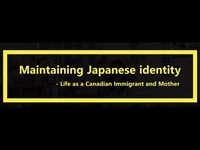Items
Tag
Maintaining Traditions
-
 Maintaining Japanese identity: Life as a Canadian immigrant and Mother The video explores the life of Chigusa Peters who is a new Japanese immigrant to London, Ontario and also a mother of three daughters. During the interview, Chigusa first talks about her own identity and the difficulties she encountered in adapting to Canadian culture. She also discusses the differences between life in Canada and life in Japan. In the hopes of passing on Japanese traditions to her daughters, she takes them to karate classes every Monday and Wednesday, and to the Japanese language school every Saturday morning. The video ends with her talking about which aspects of Japanese culture she hopes her kids will be able to learn through these activities.
Maintaining Japanese identity: Life as a Canadian immigrant and Mother The video explores the life of Chigusa Peters who is a new Japanese immigrant to London, Ontario and also a mother of three daughters. During the interview, Chigusa first talks about her own identity and the difficulties she encountered in adapting to Canadian culture. She also discusses the differences between life in Canada and life in Japan. In the hopes of passing on Japanese traditions to her daughters, she takes them to karate classes every Monday and Wednesday, and to the Japanese language school every Saturday morning. The video ends with her talking about which aspects of Japanese culture she hopes her kids will be able to learn through these activities. -
 Memories in The Present Katherine Tibasosa, originally from Bogota, Colombia, moved to London, Ontario about a year ago with her husband and children. Katherine discusses the significance of weather, different regions in her country, and traditional foods. Moreover, since coffee is a very significant part of Colombian culture and Katherine's life, she opens up about how she keeps that aspect of her culture alive here in London. This video focuses on how she keeps the various aspects of her culture alive since moving from Colombia.
Memories in The Present Katherine Tibasosa, originally from Bogota, Colombia, moved to London, Ontario about a year ago with her husband and children. Katherine discusses the significance of weather, different regions in her country, and traditional foods. Moreover, since coffee is a very significant part of Colombian culture and Katherine's life, she opens up about how she keeps that aspect of her culture alive here in London. This video focuses on how she keeps the various aspects of her culture alive since moving from Colombia. -
 Small Country, Big Celebrations: The Role of Salvadoran Celebrations in Cultivating Identity and Belonging In this video, Claudia calls attention to a part of her culture that is often overlooked. In contrast to holidays celebrated in Canada, national celebrations in El Salvador take place out on the streets and bring together an entire community. She considers the major role that climate and religion play in building a sense of community in El Salvador. Drawing on childhood memories, she describes celebrations such as Virgen de Guadalupe, Día de la Cruz, and Semana Santa, which are all rooted in a shared religion. In addition, she reflects on the unifying power of street celebrations, and how they function to gather people of different backgrounds in a common place. In the conclusion, Claudia provides her definition of community which is influenced by her experiences with celebrations and traditions. Her definition further encompasses what it means to be a part of a community in a new country.
Small Country, Big Celebrations: The Role of Salvadoran Celebrations in Cultivating Identity and Belonging In this video, Claudia calls attention to a part of her culture that is often overlooked. In contrast to holidays celebrated in Canada, national celebrations in El Salvador take place out on the streets and bring together an entire community. She considers the major role that climate and religion play in building a sense of community in El Salvador. Drawing on childhood memories, she describes celebrations such as Virgen de Guadalupe, Día de la Cruz, and Semana Santa, which are all rooted in a shared religion. In addition, she reflects on the unifying power of street celebrations, and how they function to gather people of different backgrounds in a common place. In the conclusion, Claudia provides her definition of community which is influenced by her experiences with celebrations and traditions. Her definition further encompasses what it means to be a part of a community in a new country. -
 Integrating Japanese Culture into Canada In this portrait, Keiko Yano talks about the different aspects of the Japanese culture being adapted to Canada such as Girl’s Day and tea ceremony. She explains her participation in the community and her wish to keep the culture alive within her daughters. Keiko’s daughter, Erika, then briefly explains why she continues to learn the Japanese language. After that Keiko’s husband, Chris, describes the significance of Buddhism practices to him and discusses the activeness of the Japanese community in London. The portrait then ends with Keiko expressing her renewal of self and deeper appreciation in the Japanese culture by coming to Canada.
Integrating Japanese Culture into Canada In this portrait, Keiko Yano talks about the different aspects of the Japanese culture being adapted to Canada such as Girl’s Day and tea ceremony. She explains her participation in the community and her wish to keep the culture alive within her daughters. Keiko’s daughter, Erika, then briefly explains why she continues to learn the Japanese language. After that Keiko’s husband, Chris, describes the significance of Buddhism practices to him and discusses the activeness of the Japanese community in London. The portrait then ends with Keiko expressing her renewal of self and deeper appreciation in the Japanese culture by coming to Canada. -
 Raising Children in a German-Canadian Household: The Importance of Language and Culture This portrait follows the life of a German woman, Kordula, who immigrated to southwestern Ontario in 1999 in order to farm. The portrait specifically focuses on her journey in raising her children in a German-Canadian household. The portrait captures how she tried to preserve German traditions and the German language while raising her children amidst the backdrop of southwestern Ontario. It touches on why language is important to her and her children’s upbringing, indicating that it has allowed them to foster their German-Canadian identity. She also gives advice for families who have immigrated, and wish to continue teaching their children about their culture.
Raising Children in a German-Canadian Household: The Importance of Language and Culture This portrait follows the life of a German woman, Kordula, who immigrated to southwestern Ontario in 1999 in order to farm. The portrait specifically focuses on her journey in raising her children in a German-Canadian household. The portrait captures how she tried to preserve German traditions and the German language while raising her children amidst the backdrop of southwestern Ontario. It touches on why language is important to her and her children’s upbringing, indicating that it has allowed them to foster their German-Canadian identity. She also gives advice for families who have immigrated, and wish to continue teaching their children about their culture.